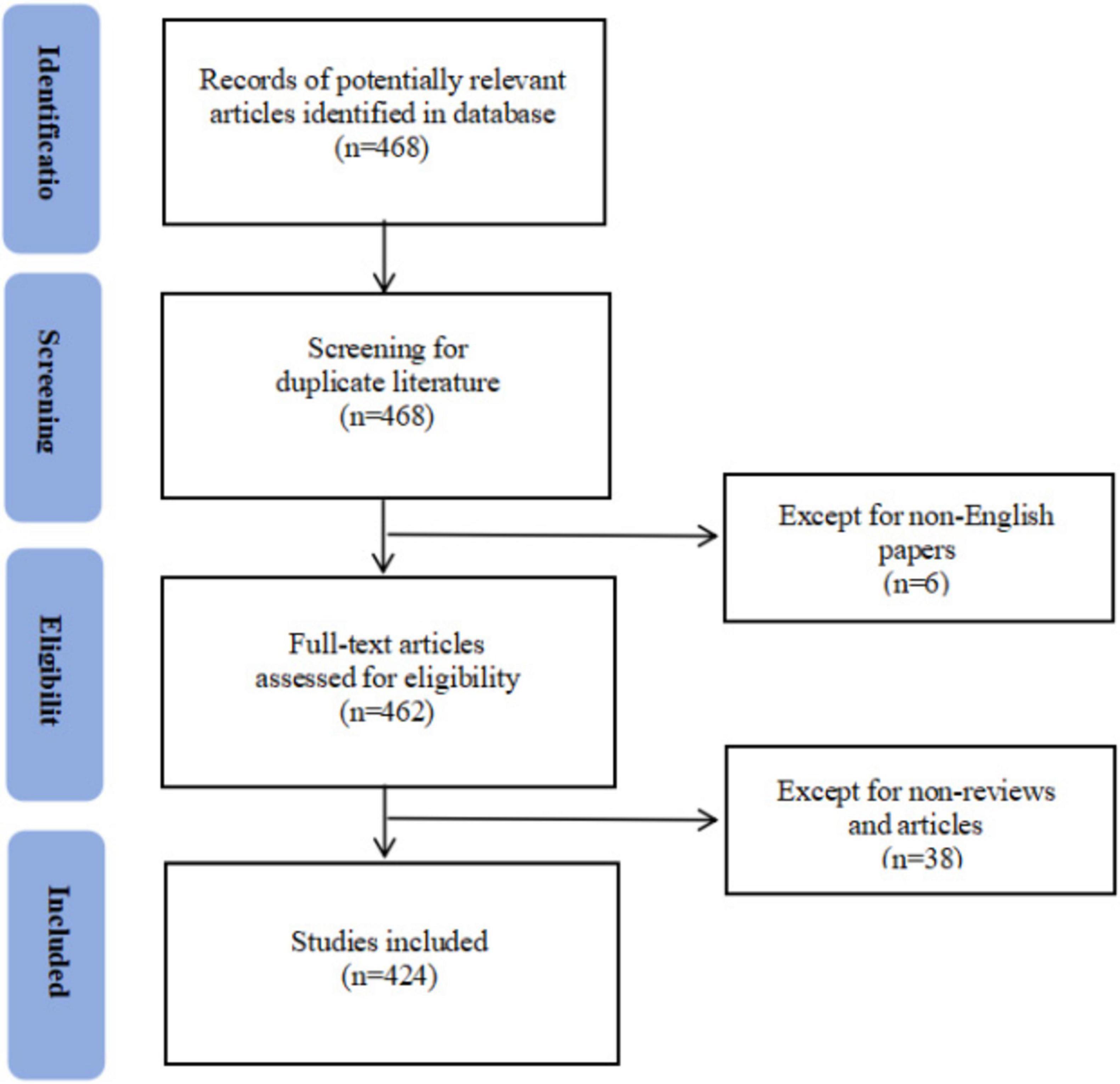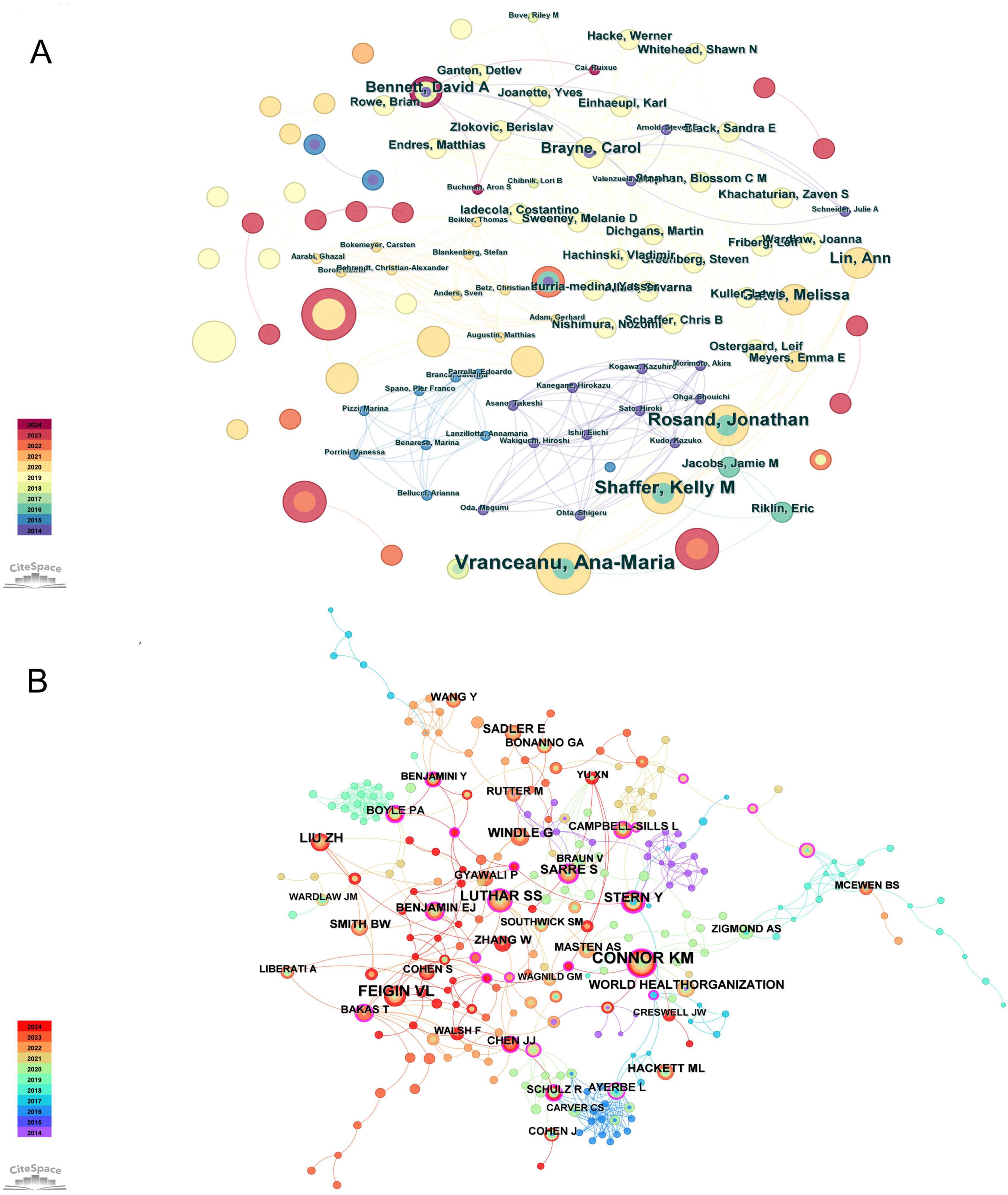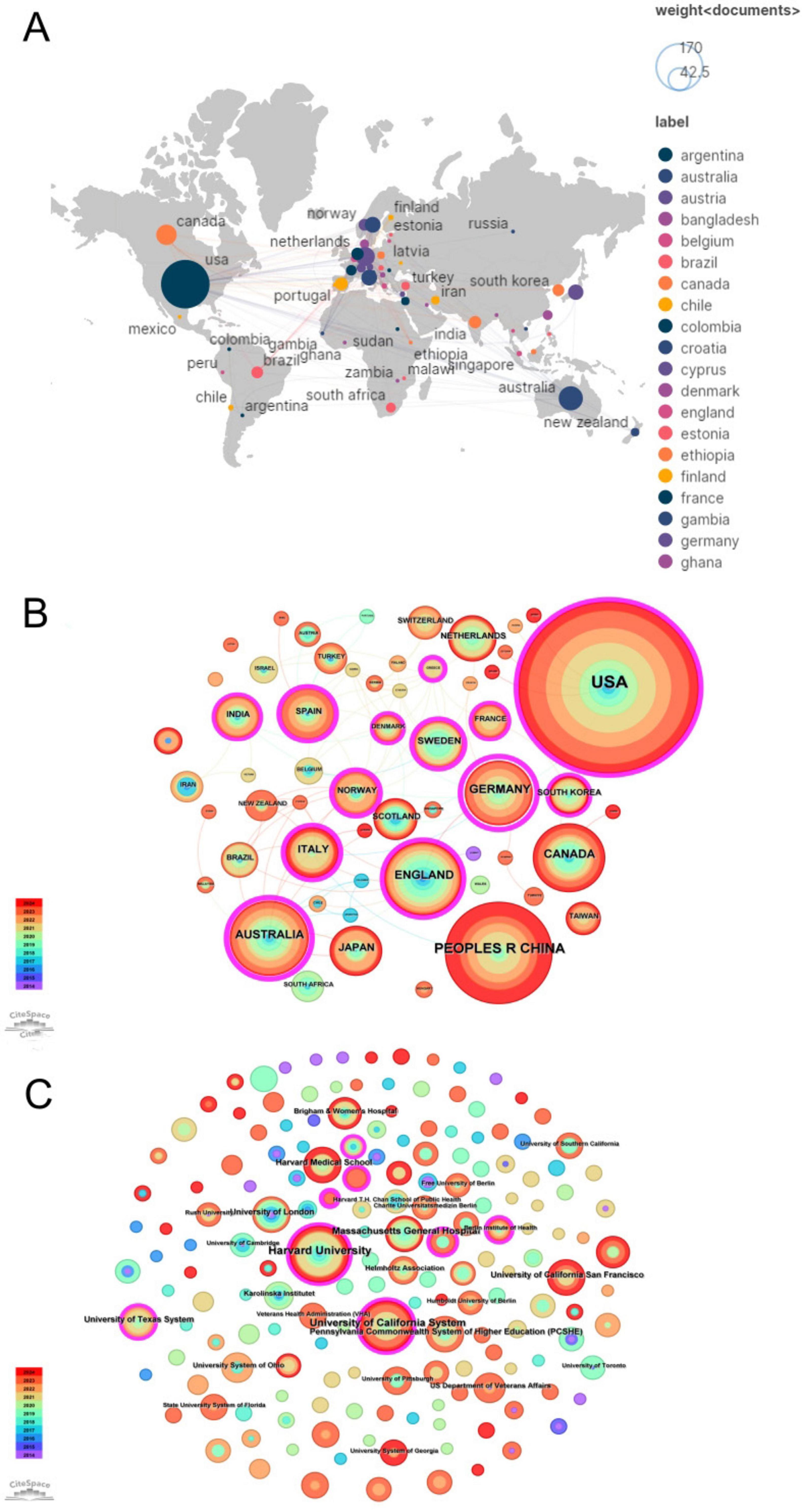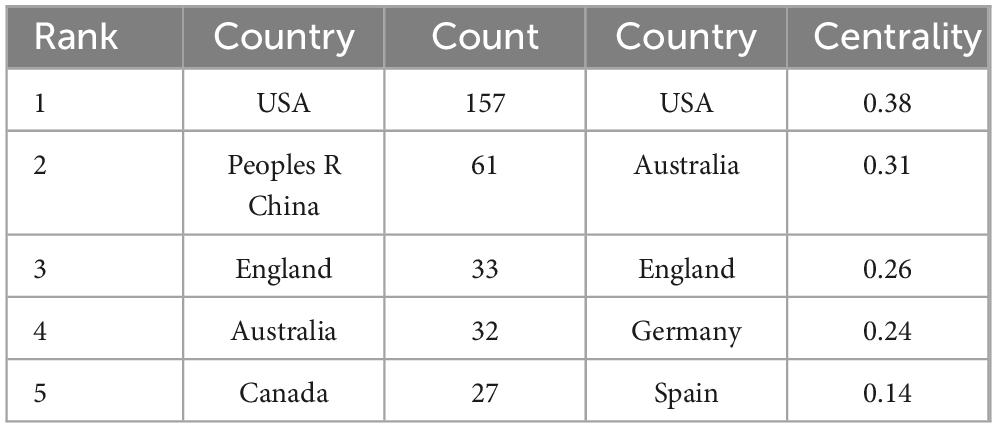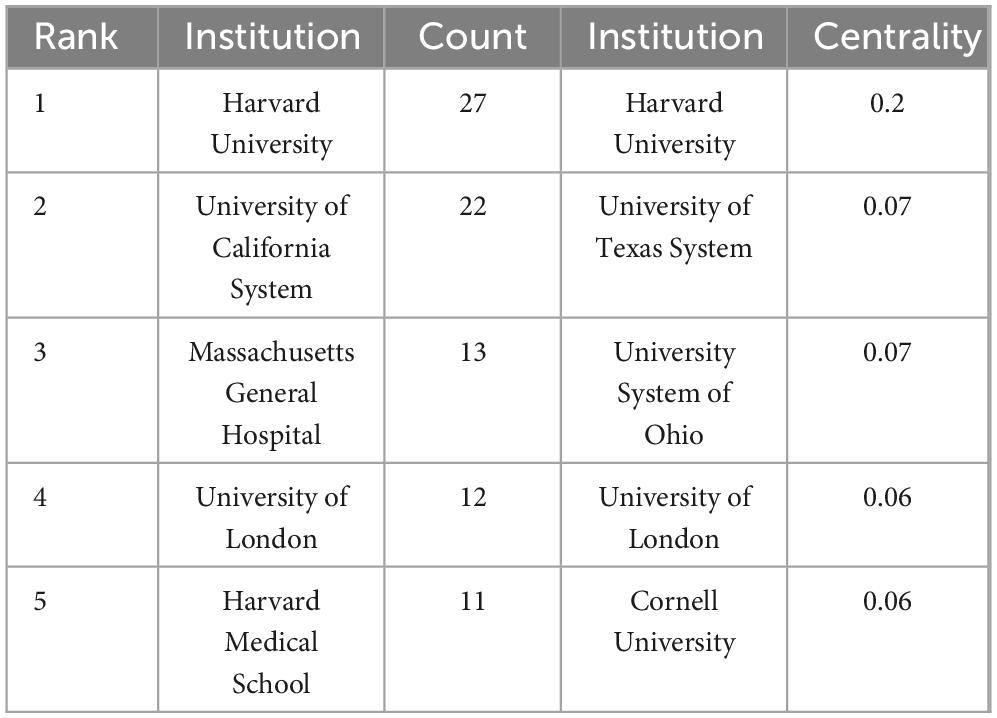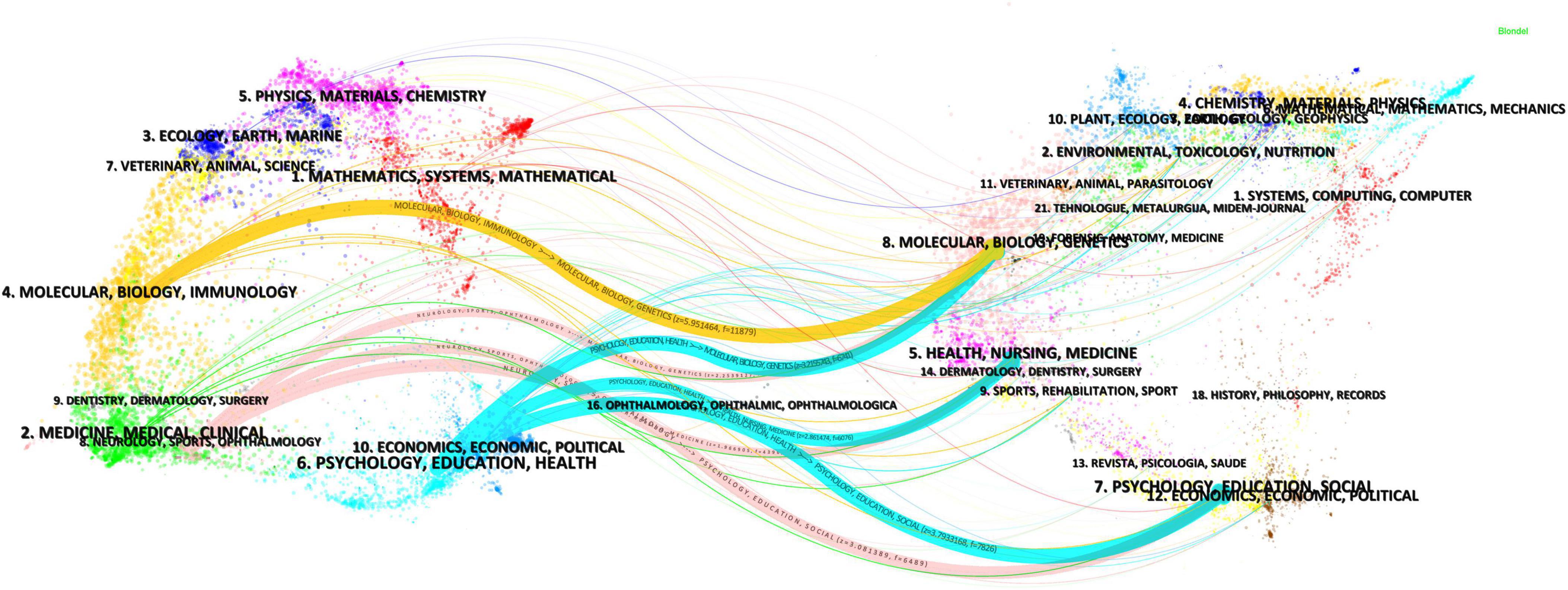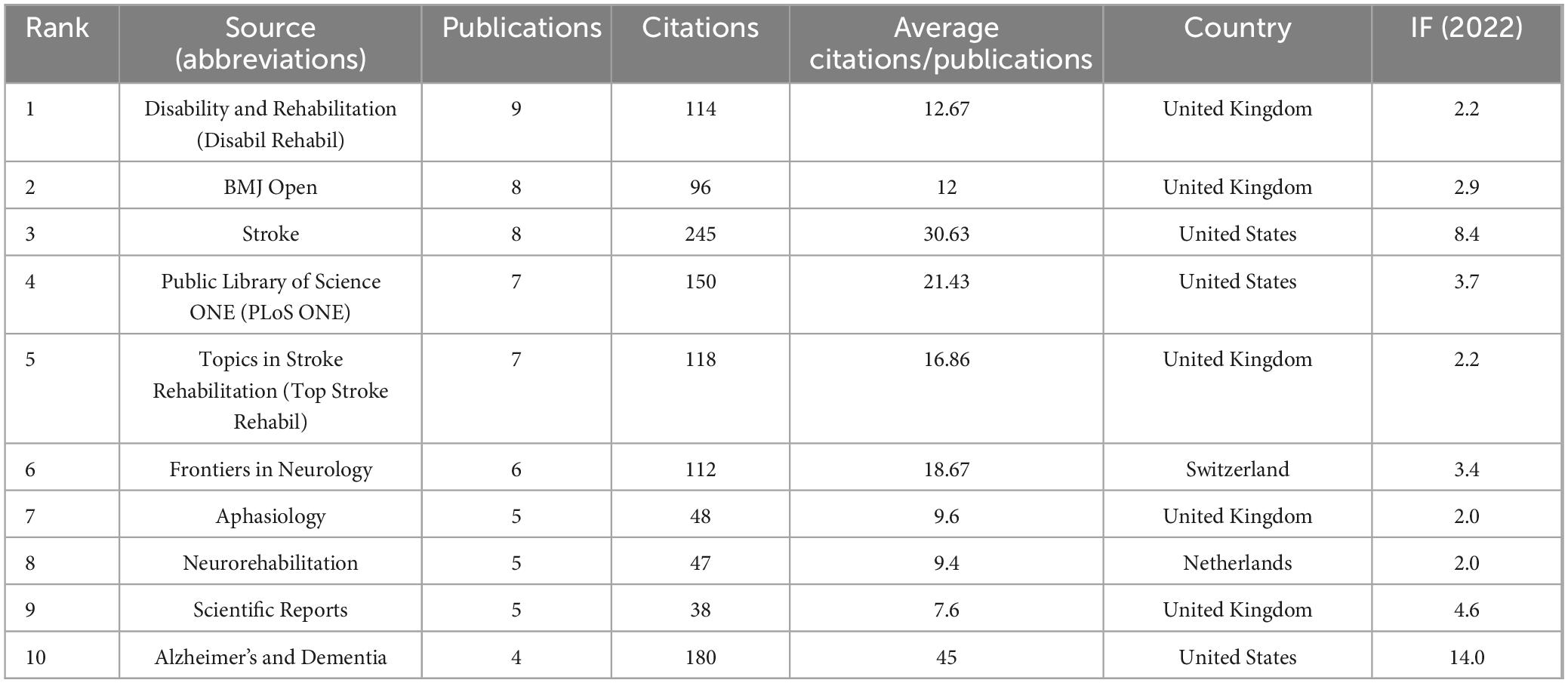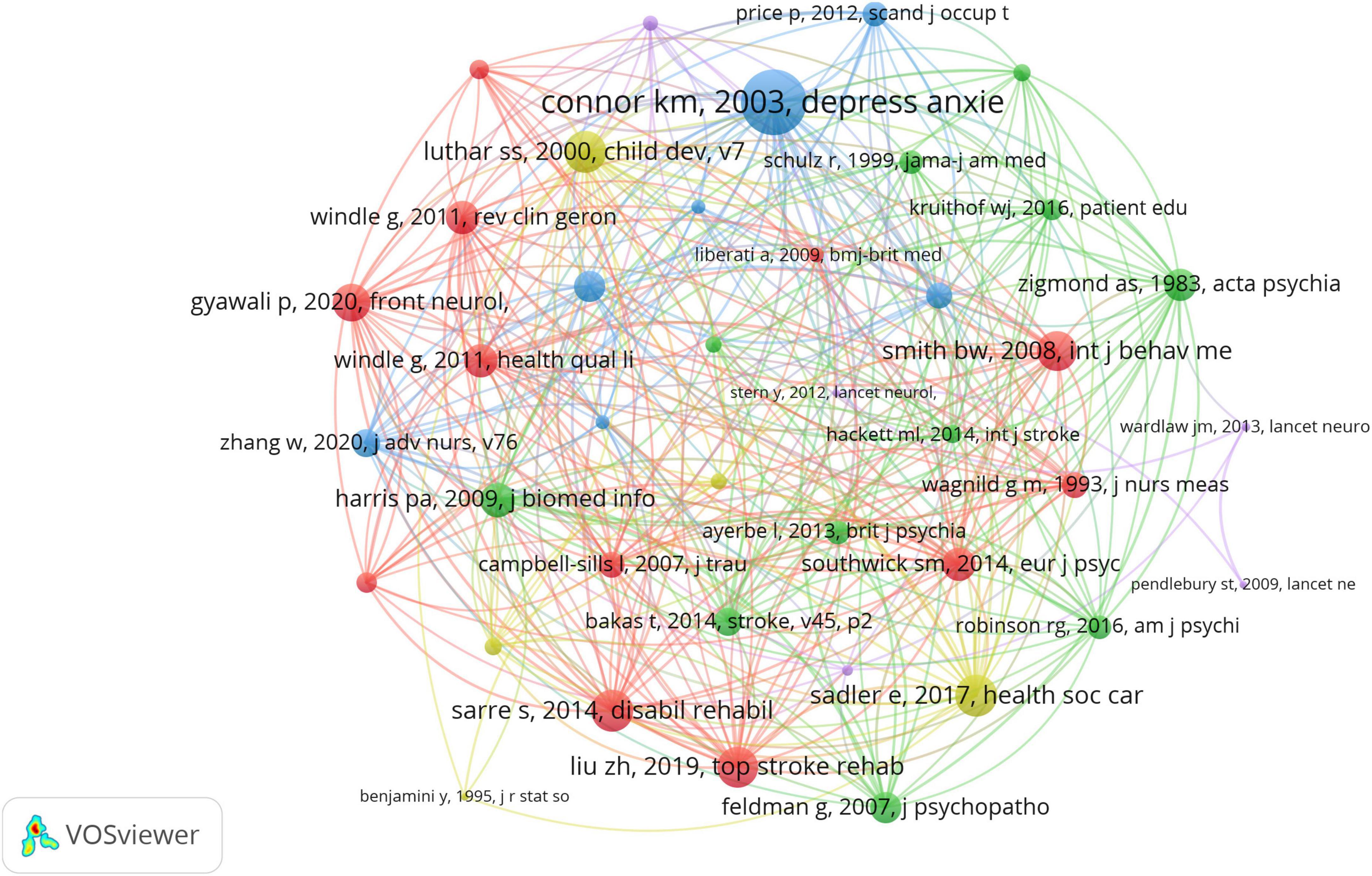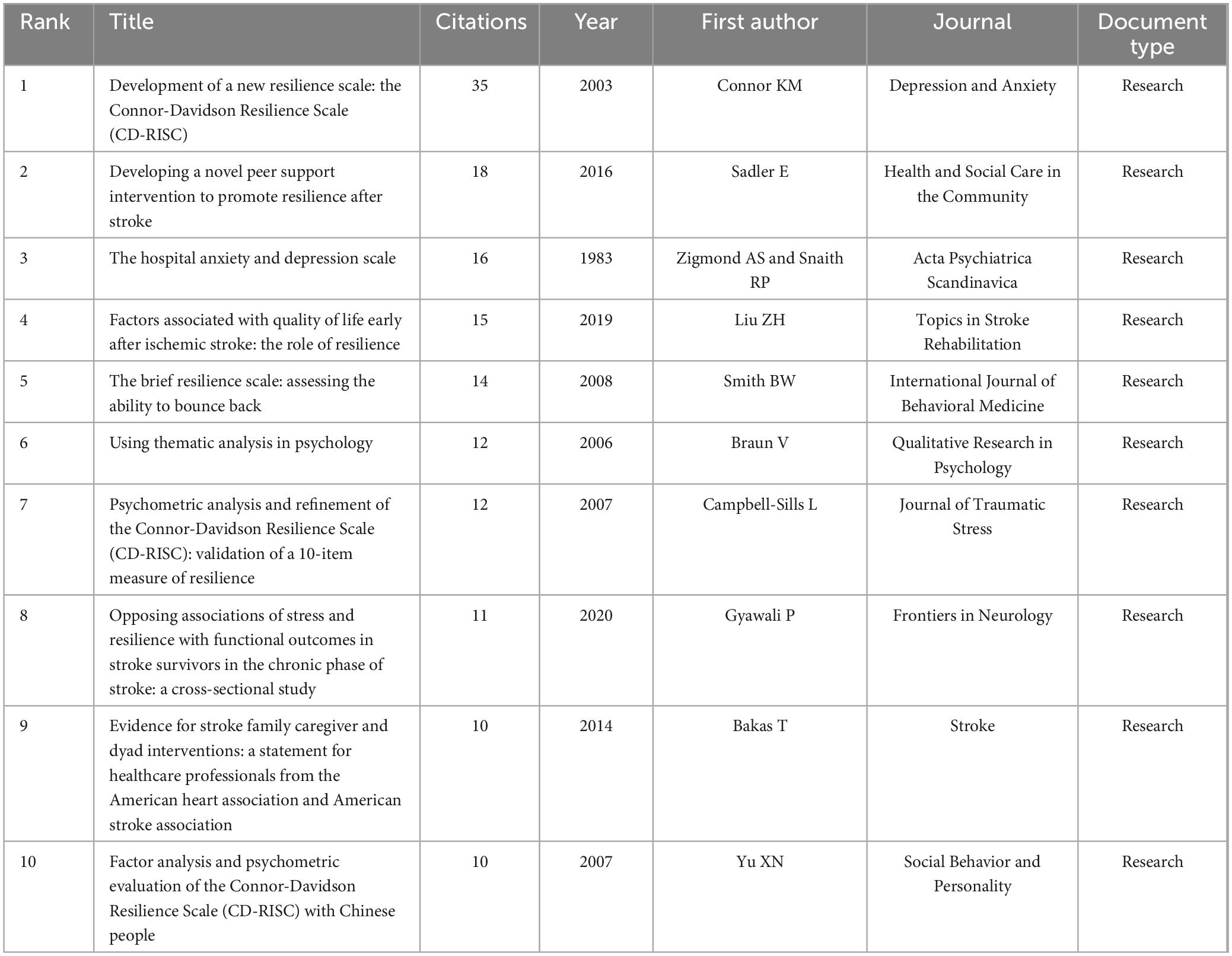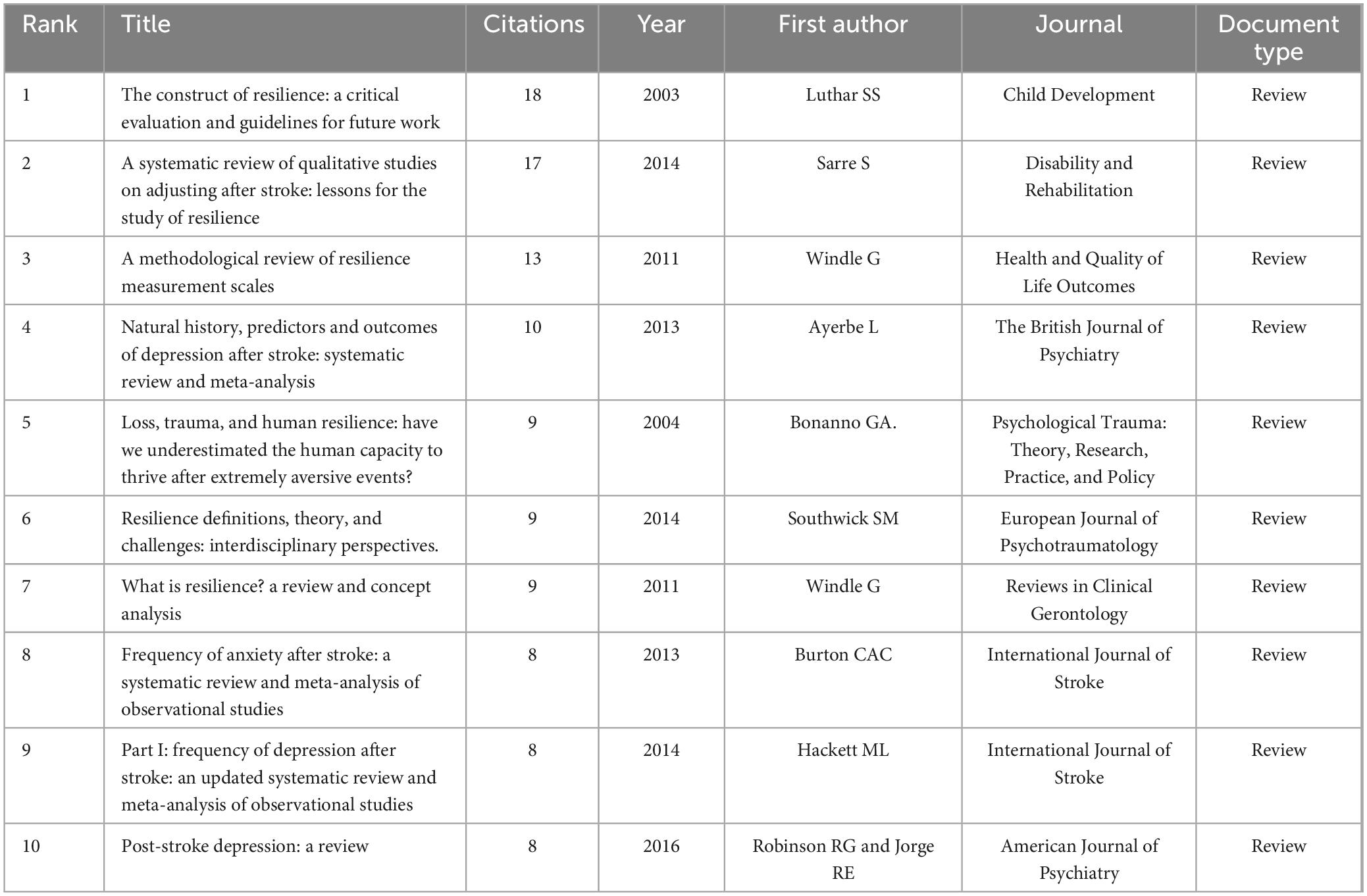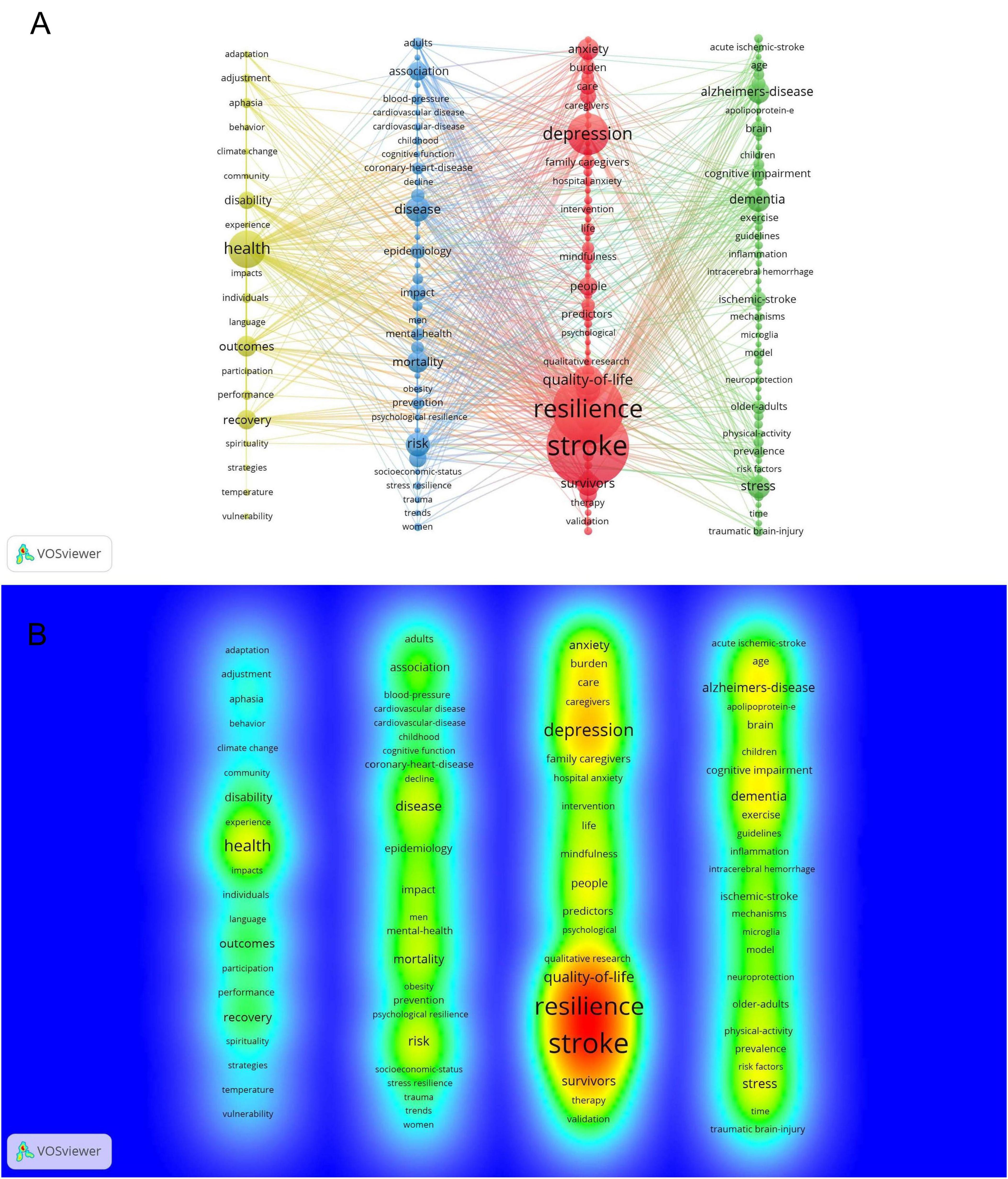- 1Department of Nursing, Faculty of Medicine and Health Sciences, Universiti Putra Malaysia, Serdang, Malaysia
- 2Department of Neurology, Zibo Central Hospital, Zibo, Shandong, China
- 3Department of Dean’s Office, The Affiliated Hospital of Qingdao University, Qingdao, Shandong, China
- 4Department of Sports Studies, Faculty of Educational Studies, Universiti Putra Malaysia, Serdang, Malaysia
Objective: This study aims to conduct a bibliometric analysis of research literature on psychological resilience among stroke survivors published from 2000 to 2024, utilizing VOSviewer and CiteSpace.
Methods: The literature data was sourced from the Web of Science Core Collection database (WoSCC). A total of 424 relevant articles, published between January 1, 2000, and April 30, 2024, were included. To analyze the literature, the software tools CiteSpace and VOSviewer were employed, examining perspectives such as authorship, country of origin, institutions, journals, references, and keywords.
Results: Since 2015, the annual publication output has steadily increased, reaching a peak in 2022 (65 articles). The United States is the most prolific contributor, with Harvard University being the leading institution in this field. Zhang W and Vranceanu A have emerged as the authors with the highest productivity, each boasting five published articles. “Stroke” is the most co-cited journal (204 times) with a high impact factor (IF 2022, 8.4). The most frequently occurring keywords are “stroke,” “resilience,” “depression,” “health,” and “quality of life.” Emerging trends include research on post-stroke cognitive impairment, meta-analyses, population differences, guideline development, and symptom management.
Conclusion: This bibliometric study indicates the increased scholarly interest in investigating psychological resilience among persons who have survived a stroke over the last 24 years. The United States and China have emerged as the leading contributors to this study area, with international collaboration on the rise. To enhance this subject, subsequent studies should target refining theoretical frameworks, enhancing assessment instruments, establishing evidence-based guidelines, and developing tailored therapies that increase psychological resilience and holistic well-being for stroke survivors.
1 Introduction
Stroke, a severe cerebrovascular disorder arising from the cessation of blood supply to the brain, can cause regional neural tissue injury and a spectrum of neurological abnormalities. The Global Burden of Disease research rates stroke as the second most widespread cause of mortality globally (Sirdani et al., 2021; Xiong et al., 2022). Nearly 50% of stroke survivors face varying levels of disability, which can manifest as deficits in motor control, sensory perception, speech, and cognitive function, significantly impairing their capacity to carry out everyday tasks and reducing their overall quality of life (Nikolovska and Taci, 2023; Fan and Lei, 2022). Beyond physical restrictions, stroke survivors frequently battle with deep psychological issues, such as depression, anxiety, panic disorder, and post-traumatic stress disorder (Gugliandolo et al., 2021; Ohashi et al., 2023). These unfavorable emotional states not only aggravate patients’ functional limitations and disability but also emerge as crucial determinants influencing stroke recovery (Stuckey et al., 2021; Xiong et al., 2022). Consequently, stroke rehabilitation should focus not only on the recovery of physical function but also on the maintenance and promotion of patients’ mental health (Nikolovska and Taci, 2023; Fan and Lei, 2022).
Psychological resilience, defined as an individual’s capacity to maintain positive adaptation and sustain physical and mental health when confronted with adversity, plays an important role in the rehabilitation of stroke survivors. Studies have demonstrated that stroke patients possessing high levels of psychological resilience exhibit a greater ability to accept the reality of their condition, adapt their mindset, and actively participate in rehabilitation training, ultimately leading to superior functional outcomes in daily living activities and social engagement (Han et al., 2021; Heltty and Zahalim, 2023). Moreover, psychological resilience serves as a protective factor against emotional disorders commonly experienced by stroke survivors, such as depression and anxiety, thereby promoting overall quality of life and well-being (Tsai et al., 2023; Norvang et al., 2022). Considering the vital importance of psychological resilience in stroke rehabilitation, there is a pressing need to intensify research efforts in this area (Yan and Lin, 2022; Zhang et al., 2022).
Traditional reviews focus on the elaboration of article content and struggle to reveal hot topics in research themes and collaboration among scholars. Bibliometric analysis, a method that applies mathematical and statistical techniques, is used to gather and analyze literature data such as authors, countries, institutions, keywords, cited authors, and cited journals through specialized software. This approach employs quantitative methods to uncover the macro-level landscape of a field (Donthu et al., 2021), providing insights into the development trends of a discipline (Muraleedharan and Chandak, 2023). Bibliometric analysis, a commonly employed technique in various disciplines including biomedicine, social sciences, engineering, technology, and management, enables researchers to identify potential collaborators in the field of stroke psychological resilience research. This approach enables academics to understand the history of research focal points and actively assess the developing landscape of the field. By utilizing this complete approach, scholars can acquire a thorough comprehension of the current state of research on psychological resilience in stroke survivors and predict future investigation paths (Chen et al., 2023; Bin Suliman et al., 2023).
In recent years, there has been a rising interest in the literature concerning psychological resilience among stroke survivors. This indicates that researchers are increasingly concentrating on the relationship between post-stroke psychological resilience and rehabilitation outcomes. Despite this growing interest, no bibliometric studies have been specifically conducted on psychological resilience among stroke survivors. Given the importance of psychological resilience in stroke rehabilitation, it is essential to utilize bibliometric methods to thoroughly analyze the development context of relevant national and global research. This approach will help researchers identify research hotspots, foundational knowledge, and frontier dynamics within the field, ultimately providing direction and guidance for future, in-depth studies of psychological resilience among stroke survivors.
2 Materials and methods
2.1 Search strategy
This study relied on the Web of Science Core Collection (WoSCC) to retrieve relevant literature. As a widely recognized high-quality digital literature database, WoSCC is frequently considered the optimal resource for conducting bibliometric analyses (Yan and Zhiping, 2023). The Science Citation Index (SCI) Expanded (1900-present) was selected as the retrieval citation index to guarantee the thoroughness and accuracy of the collected data (Liu et al., 2021).
The search strategy was as follows: TS = (“stroke*” OR “cerebrovascular accident*” OR “cerebrovascular disorder*” OR “cerebrovascular disease*” OR “brain vascular accident*” OR “brain ischemia*” OR “cerebral infarction*” OR “intracranial hemorrhage*”) AND TS = (“resilience” OR “psychological resilience” OR “psychosocial resilience” OR “emotional resilience” OR “mental resilience” OR “post-stroke resilience”). The search time range was set from January 1, 2000, to April 30, 2024, to cover the latest advances in stroke psychological resilience research since the beginning of the 21st century. The main types of literature included in the analysis were research articles and review articles, to comprehensively reflect the original research results and summary views in the field. Considering that English is the common language in international research, we limited the language of the literature to English to ensure the readability of the included literature and the universality of the research results.
After initial retrieval and screening, we finally included 424 articles for subsequent bibliometric analysis.
2.2 Analysis tools
To comprehensively analyze the bibliometric characteristics of the literature of literature related to stroke and psychological resilience, this study employed a variety of bibliometric analysis tools and visualization software. First, we used Microsoft Excel 2019 for preliminary statistics and analysis of the raw literature data, including basic characteristics such as the annual distribution of published literature and the composition of literature types.
Next, we conducted a more in-depth bibliometric analysis and visualization using CiteSpace 6.2.3 R3 and VOSviewer 1.6.17 software. CiteSpace is a Java-based information visualization software and a visualization analysis tool capable of exploring the knowledge potential in scientific literature (Markscheffel and Schröter, 2021; Chen et al., 2023). VOSviewer is also a Java-based visualization software developed by Leiden University in the Netherlands, primarily used for constructing and viewing bibliometric knowledge maps. Both software packages are widely applied in bibliometric research (Markscheffel and Schröter, 2021; Chen et al., 2023).
Using these tools, we performed comprehensive bibliometric analyses of the literature on resilience in stroke survivors from multiple perspectives, including author collaboration networks, country distribution characteristics, institutional collaboration patterns, journal citation patterns, and the structure and distribution of research topics and hotspots. This provided data support for understanding the developmental trajectory and future trends in this field.
2.3 Research ethics
This study was conducted as a bibliometric analysis. All data were sourced from online resources, and no animals or human subjects were involved. Therefore, ethical approval from an ethics committee was not required.
3 Results
3.1 Analysis of publication output and citations
From January 1, 2000, to April 30, 2024, the Web of Science Core Collection database yielded a total of 424 articles that satisfied the inclusion criteria, comprising 344 research articles and 80 review articles (Figure 1). Figure 2A shows the distribution of annual publications. The results indicate that 2022 was the year with the highest publication output, reaching 65 articles. Overall, the field’s annual scholarly output has shown a steady increasing trend since 2015. These 424 articles have been cited a total of 8,815 times, with 2021 recording the highest number of citations at 1,045 (Figure 2B). Most publications have appeared within the past 5 years, indicating that research on resilience in stroke survivors is a rapidly evolving field that is attracting increasing attention from researchers.
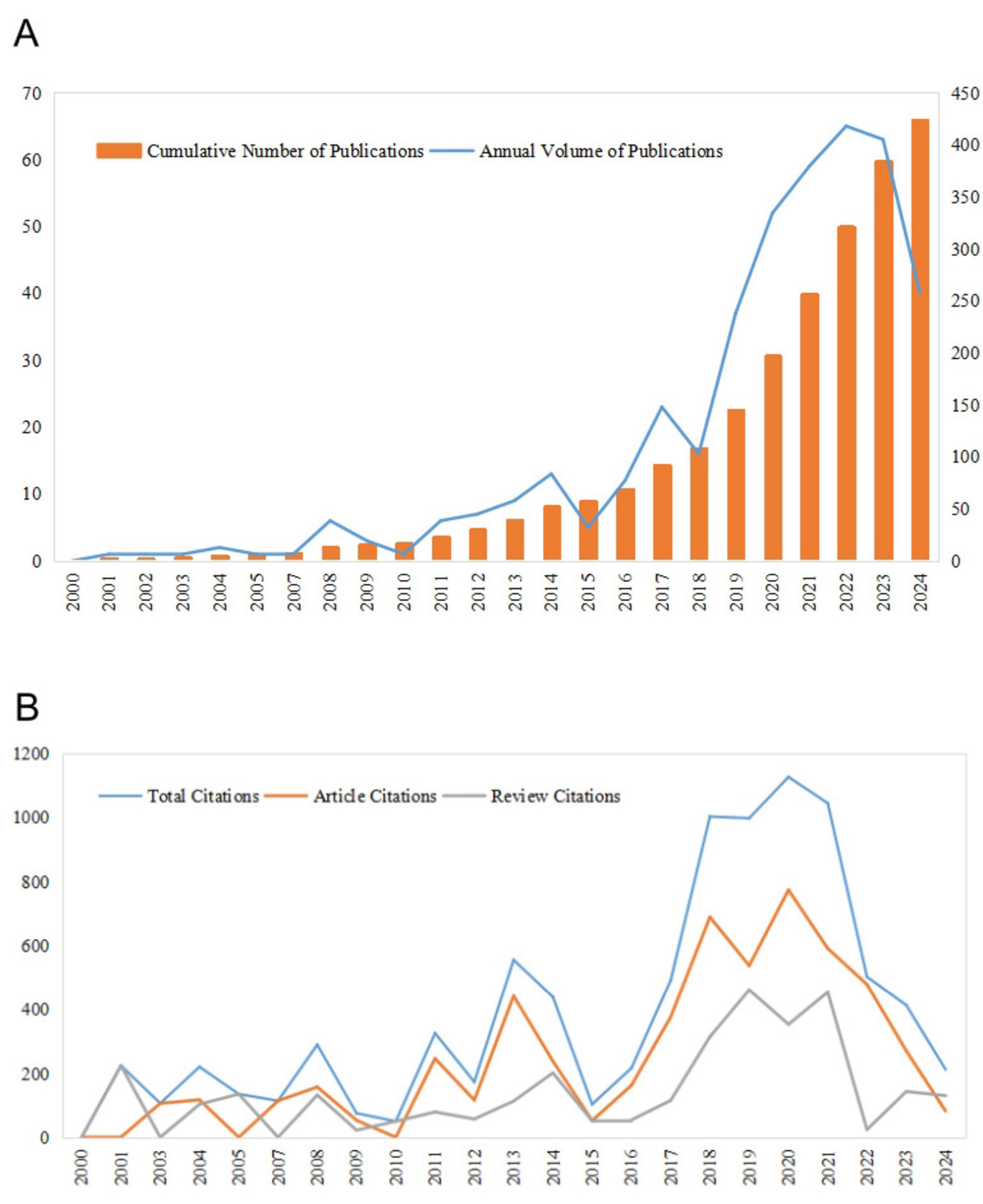
Figure 2. The quantity of publications and citations. (A) The publication output and its growth trend from 2000 to 2024. (B) The annual citation count from 2000 to 2024.
3.2 Analysis of authors and co-cited authors
The author collaboration network generated using CiteSpace (Figure 3A) shows that a total of 1,582 authors contributed to the publication of 424 articles. Node size represents the publication volume of authors, while connections indicate collaborative relationships. Table 1 lists the top five authors ranked by publication count, with Zhang W and Vranceanu A tied for first place with five publications, followed by Donlon A, Rosand J, and Shaffer K (four articles each). Meanwhile, the co-cited author network analysis (Figure 3B) reveals that Connor KM (33 citations) is the most frequently cited author, followed by Feigin VL (27 citations), Luthar SS (21 citations), Liu ZH (17 citations), and Windle G (14 citations). Among co-cited authors, Boyle PA demonstrated the highest centrality (0.21). The research contributions of these authors and highly cited researchers collectively constitute the core knowledge foundation for resilience research in stroke survivors.
3.3 Analysis of countries and institutions
As shown in Figure 4A, publications in this research field originated from 58 countries/regions. The top five countries contributed over 72% of the publications, with the United States (37.03%, 157/424), China (14.39%, 61/424), and the United Kingdom (7.78%, 33/424) ranking as the top three. We used CiteSpace to analyze all articles published between 2000 and 2024 to explore the relationships between publications from different countries. As illustrated in Figure 4B, the analysis generated a merged network comprising 58 nodes and multiple connections. The node size represents publication volume, with larger nodes indicating a higher number of publications, while the links signify collaborative relationships between countries. Table 2 lists the top five countries ranked by publication volume and centrality, with the United States leading in both aspects (157 publications, centrality 0.38), demonstrating its important role in this field.
At the institutional level, we selected “institution” as the node to generate an institutional distribution map (Figure 4C), where larger nodes represent higher publication volumes. Table 3 presents the top five most productive institutions in this research field. Harvard University leads with 27 publications, followed by the University of California System with 22 publications, and Massachusetts General Hospital ranking third with 13 publications. Four of the top five institutions are located in the United States, with only the University of London from the United Kingdom, further emphasizing the United States’ leadership in research on psychological resilience among stroke survivors.
3.4 Analysis of journals and co-cited journals
In the field of psychological resilience research among stroke survivors, based on the analysis of 393 journals containing relevant literature. Figure 5 presents the findings of the dual-map analysis of journals. The map on the left illustrates the citing literature, while the map on the right represents the cited literature, with curves denoting citation links. The paths of these links expose the transdisciplinary flow of information within this topic. The z-value function amplifies the trajectories with stronger flow; the higher the z-value, the thicker the link appears. This study reveals that the literature in the fields of neuroscience, kinesiology, and ophthalmology (indicated by the pink trajectory) was significantly influenced by the publications from psychology, education, and sociology (z = 3.08, f = 6,489), as well as health sciences, nursing, and medicine (z = 1.97, f = 4,396). Additionally, the literature in molecular biology, biology, and immunology (represented by the blue trajectory) was impacted by the works in health sciences, nursing, and medicine (z = 3.79, f = 7,826), while the literature in health sciences, nursing, and medicine (another blue trajectory) was influenced by the literature from psychology, education, and sociology (z = 3.22, f = 6,741). The literature in the fields of medicine, pharmaceuticals, and clinical practice (yellow trajectory) mainly influenced the literature in the fields of environmental science, toxicology, and nutrition (z = 5.95, f = 11,879).
Table 4 lists the top 10 journals by publication output. Among them, “Disability and Rehabilitation” ranks first with 9 articles, playing an important role in this field. Additionally, Table 5 lists the five journals with the highest co-cited frequency.
3.5 Analysis of co-cited references
To investigate the co-citation of references, we used VOSviewer to construct a co-citation network map of references (Figure 6). From 25,269 references, we selected a minimum co-citation frequency threshold of eight, ultimately including 41 references for co-citation analysis. Through this study, we constructed a knowledge network for the field of resilience research in stroke survivors. Table 6 lists the top 10 most frequently co-cited research articles, while Table 7 presents the top 10 most frequently co-cited review articles.
3.6 Analysis of keywords
As of April 2024, a total of 2,079 keywords were identified in this research field. Using VOSviewer software, we set a minimum co-occurrence frequency of five, resulting in the inclusion of 165 keywords in the analysis (Figure 7A). In this visualization, nodes represent keywords, node size reflects keyword co-occurrence frequency, and links indicate the strength of associations between keywords, thus constructing a knowledge structure map of the field. Meanwhile, to provide a more intuitive representation of research hotspot, we generated a density visualization map of keywords (Figure 7B), where warmer colors (red areas) indicate higher research focus. Additionally, to reveal the temporal evolution of research hotspots, we conducted the strongest citation bursts of keywords (Table 8), with time intervals represented by blue lines and keyword burst periods indicated by red lines. The analysis results show that the keyword “resilience” had a burst strength of 2.97, with a burst period from 2019 to 2022.
4 Discussion
4.1 Development trends and overall characteristics of psychological resilience research among stroke survivors
Academic publication volume is an important indicator for measuring the developmental trajectory of a research field (Zafar and Masood, 2020). Figure 2A illustrates the publication trends in psychological resilience among stroke survivors from 2000 to 2024. The data show that the annual scholarly output has demonstrated a steady increasing trend since 2015, reaching a peak in 2022 (65 articles). This growth pattern reflects the growing recognition of the importance of psychological resilience after stroke (Feigin et al., 2021). As the significance of resilience in stroke rehabilitation has been increasingly validated, related research has evolved from early exploration into an active research domain (Liew et al., 2023). The citation analysis in Figure 2B further supports this developmental trend, showing significant growth in the field’s scholarly impact, with annual citation frequency reaching 1,045 in 2021, and 212 citations already recorded in the first 4 months of 2024, suggesting a sustained high citation rate throughout the year. These findings indicate that research on psychological resilience in stroke survivors has become a continuous scholarly attention, with its scientific value and clinical significance widely acknowledged by researchers (Tsai et al., 2023; Love et al., 2022).
With the continuous expansion of research on resilience in stroke survivors, this study reveals the distribution of scientific research and their significant impact on disciplinary development through analysis of publication volumes by countries, institutions, and authors (Figure 4A). Country analysis results (Figure 4B, Table 2) show that the United States leads the field with 157 publications and the highest centrality (0.38), followed by China (61 publications) and the United Kingdom (33 publications). This distribution pattern is significant for understanding global research development trends in resilience among stroke survivors, revealing the dominant role of developed countries in this field while also demonstrating the research potential of developing countries such as China, providing data support for researchers selecting international collaborators (Muñoz-Venturelli et al., 2022). Meanwhile, through institutional analysis (Figure 4C, Table 3), this study identifies key research institutions such as Harvard University (27 publications), the University of California system (22 publications), and Massachusetts General Hospital (13 publications), providing clear opportunities for academic exchange and collaboration. Author collaboration network analysis (Figures 3A,B) reveals a limited connections between different researchers. While this pattern might partially reflect methodological factors such as variations in author name formats or institutional naming in the database, it likely indicates opportunities for enhanced collaboration in the field of stroke resilience research. This finding suggests the need for strengthening future interdisciplinary and inter-institutional cooperation. Meanwhile, co-cited author analysis (Figure 3C, Table 1) identifies core academic influencers such as Connor KM and Feigin VL. These multi-level analytical results collectively reveal the global scientific research distribution pattern in resilience research among stroke survivors, providing an empirical foundation for optimizing resource allocation and international collaboration in the field of psychological resilience research in stroke (Muñoz-Venturelli et al., 2022).
While analyzing the global distribution of research efforts, this study systematically examined journals and references, revealing the knowledge dissemination network and theoretical development trends in resilience research among stroke survivors, providing new perspectives for understanding the disciplinary structure. The journal analysis (Table 4) identifies Disability and Rehabilitation as the leading journal in terms of publication volume, with nine articles. More importantly, the overall distribution indicates that rehabilitation medicine, neuroscience, and other multidisciplinary journals collectively form the knowledge dissemination system in this field. Co-cited journal analysis (Table 5) further confirms this multidisciplinary characteristic, with “Stroke” (204 citations), “PLoS ONE” (155 citations), and “Proceedings of the National Academy of Sciences” (120 citations) ranking at the top, indicating that stroke resilience research draws on knowledge foundations from both specialized neurology and comprehensive scientific journals. This journal pattern reflects the interdisciplinary nature of psychological resilience research in stroke, suggesting that stroke resilience research requires the integration of multidisciplinary perspectives, establishing a foundation for promoting more comprehensive theoretical construction and intervention strategy development (Chen et al., 2023; Dong et al., 2022).
Dual-map overlay analysis (Figure 5) further shows that literature in neuroscience is significantly influenced by psychology, education, and sociology (z = 3.08, f = 6,489) as well as health sciences, nursing, and medicine (z = 1.97, f = 4,396). This finding confirms the important role of multidisciplinary integration in stroke resilience research, providing directional references for guiding future interdisciplinary collaborations (Kanwal et al., 2022; Lo et al., 2023). Reference co-citation analysis (Figure 6, Tables 6, 7) reveals the core theoretical sources in this field, with Connor and Davidson’s assessment tool research (35 citations) and Luthar et al.’s research (18 citations) emerging as the most influential references. The identification of these highly co-cited reference plays an important role in deepening stroke resilience research: on one hand, it clarifies the most recognized theoretical tools and conceptual frameworks in existing research (Connor and Davidson, 2003); on the other hand, it provides guidance for future research directions, helping to promote the field’s transition from conceptual exploration to evidence-based practice. Overall, these bibliometric analysis results systematically demonstrate the knowledge structure of resilience research in stroke survivors, providing empirical support for promoting theoretical development and clinical applications in this field (Qureshi et al., 2023).
4.2 Research hotspots in psychological resilience research among stroke survivors
To explore research hotspots in resilience among stroke survivors, this study conducted a systematic analysis of keywords. The keyword co-occurrence network map (Figure 7A) and density visualization map (Figure 7B) intuitively display the research hotspots and thematic distribution in this field, with results showing that core keywords such as “stroke,” “resilience,” “depression,” “health,” and “quality of life” represent the research hotspots in this area. This keyword distribution reflects an important shift in research focus from mere disease management to quality of life enhancement.
This study further revealed the temporal dynamic changes in research hotspots through strongest citation bursts (Table 8). During the period 2014–2019, the emergence of “cognitive impairment” (strength = 2.57) and “risk factors” (strength = 2.49) reflected early research focus on cognitive dysfunction and risk factors, providing references for understanding the fundamental influencing factors of psychological resilience. As research deepened, “resilience” showed significant emergence during 2019–2022 (strength = 2.97), marking it as a core concept in research. The concurrent emergence of “hospital anxiety” (strength = 2.79) and “rehabilitation” (strength = 2.11) indicated that research began to systematically explore the application value of psychological resilience in the stroke rehabilitation process. The emergence of “impact” (strength = 3.02) and “scale” (strength = 2.55) reflected research efforts to quantify the influence of psychological resilience and develop effective assessment tools, which is crucial for establishing empirical connections between psychological resilience and rehabilitation outcomes.
A significant characteristic of recent research hotspots is the development toward clinical application and individualization. The high burst strength of the “people” keyword (strength = 3.54) indicates that research has begun to emphasize a person-centered approach, with greater attention to individual differences and patient needs (Cao et al., 2022). Meanwhile, the emergence of “guidelines” (strength = 2.92) and “symptoms” (strength = 2.19) reflects growing research demands for developing standardized practice guidelines and precise symptom management (Lynch et al., 2022). These latest hotspots suggest that resilience research in stroke survivors is evolving from conceptual and theoretical levels toward practical, individualized, and standardized directions, providing important guidance for the application of psychological resilience in clinical stroke practice (Cormican et al., 2023).
4.3 Clinical implications of psychological resilience for stroke survivors
The hotspot analysis has important guiding significance for the clinical application of psychological resilience in stroke. First, resilience assessment should become an essential component of psychological evaluation for stroke survivors (Yan and Lin, 2022). Current research hotspots have expanded from simply focusing on emotional symptoms such as depression and anxiety to the comprehensive assessment of psychological resilience and quality of life, suggesting that clinical practice requires a more comprehensive evaluation system. Regarding the common cognitive impairment in stroke patients, assessment tools should be appropriately adapted to ensure applicability for patients with different functional levels.
Second, resilience cultivation should be integrated into rehabilitation therapy. Research hotspots indicate an increasingly trend of combining rehabilitation and psychological resilience, which aligns with the need for clinical resource optimization and improved patient experience (Wang et al., 2024). In practice, progressive goal setting can be incorporated into physical therapy to enhance patients’ experiences of success. This intervention approach can promote the recovery of physical function and psychological adaptability while improving rehabilitation efficiency without significantly increasing treatment complexity (Norvang et al., 2022).
Finally, clinical implementation of psychological resilience should consider both individualization and standardization. Research hotspots indicate that attention to individual patient characteristics and development of standardized guidelines have become current research trends (Wang et al., 2024). In clinical practice, intervention protocols should be personalized according to patients’ age, cultural background, disease severity, and social support status to meet the specific needs of different patients (Yan and Lin, 2022). Meanwhile, the development of standardized guidelines helps ensure intervention quality. These guidelines should clearly specify applicable populations, intervention timing, core content, and assessment methods, providing theoretical guidance for clinical practice (Qureshi et al., 2023). Through the combination of individualized implementation and standardized principles, psychological resilience interventions can be more effectively integrated into stroke rehabilitation systems, enhancing patients’ psychological adaptability and quality of life.
4.4 Study strengths and limitations
This study employed bibliometric analysis to analyze 424 publications on resilience in stroke survivors published between 2000 and 2024, providing a comprehensive understanding of the current research trends in this field. Through the application of visualization tools such as VOSviewer and CiteSpace, we conducted multi-dimensional analyses of authors, countries, institutions, journals, references, and keywords, presenting research hotspots and frontier dynamics. This study not only constructed the knowledge map of this field but also focused on the clinical application value of psychological resilience in stroke survivors, providing evidence-based support for optimizing clinical intervention strategies. This systematic bibliometric analysis also provides important references for future research directions.
However, this study has several limitations. First, due to software technical constraints, we only included English publications from the WoSCC database, potentially excluding high-quality research published in other languages. Second, this study did not differentiate between ischemic stroke and hemorrhagic stroke subtypes, while differences in these pathological mechanisms may lead to different psychological responses in patients, affecting the precision of results. Third, in the author collaboration network, we observed that low centrality values may be partially attributed to inconsistent spelling of author names, an issue difficult to resolve in the current study due to the lack of unified identifiers (such as ORCID) in the original database and the complexity of post-processing standardization techniques. Finally, when evaluating institutional influence, we were unable to distinguish between “high-productivity institutions” and “high-impact institutions,” primarily limited by technical challenges in standardizing institution names during data extraction, making it unfeasible to calculate citation frequencies for institutions.
Despite these limitations, this study still provides a systematic perspective for understanding the current status and future directions in the field of resilience among stroke survivors. Future studies may consider integrating multi-database resources, including literature in a wider range of languages, and combining qualitative content analysis to gain a more comprehensive and in-depth understanding of this field.
5 Conclusion
This bibliometric analysis examined 424 articles on resilience in stroke survivors published between 2000 and 2024. The analysis identified Zhang W and Vranceanu A as the most productive authors. The United States, China, and the United Kingdom emerged as the primary contributing countries, with Harvard University publishing 27 articles as the most productive institution. Journal analysis revealed that “Disability and Rehabilitation” and “Stroke” played significant roles in this field. Knowledge structure analysis demonstrated a shift in research focus from disease-related factors toward resilience assessment and intervention. This shift not only reflects the developmental progress in resilience research but also provides important evidence for improving rehabilitation outcomes and quality of life for stroke survivors. Future research should address psychological resilience characteristics in patients with different stroke subtypes, develop targeted assessment tools and intervention strategies, and promote the effective application of research findings in clinical practice.
Data availability statement
The original contributions presented in this study are included in this article/supplementary material, further inquiries can be directed to the corresponding author.
Author contributions
YL: Conceptualization, Data curation, Investigation, Methodology, Project administration, Software, Writing – original draft, Writing – review and editing. KLS: Conceptualization, Software, Funding acquisition, Methodology, Project administration, Supervision, Writing – review and editing. XJ: Funding acquisition, Software, Writing – review and editing. LW: Funding acquisition, Supervision, Project administration, Writing – review and editing. RR: Software, Methodology, Supervision, Writing – review and editing. KGS: Software, Writing – review and editing.
Funding
The author(s) declare that financial support was received for the research and/or publication of this article. This study was supported by the Chinese Nursing Association (ZHKY202118) and the Research Project on Quality of Care (Evidence-based) Management (YLZLXZ23G108).
Conflict of interest
The authors declare that the research was conducted in the absence of any commercial or financial relationships that could be construed as a potential conflict of interest.
Generative AI statement
The authors declare that no Generative AI was used in the creation of this manuscript.
Publisher’s note
All claims expressed in this article are solely those of the authors and do not necessarily represent those of their affiliated organizations, or those of the publisher, the editors and the reviewers. Any product that may be evaluated in this article, or claim that may be made by its manufacturer, is not guaranteed or endorsed by the publisher.
References
Bin Suliman, M. A., Hanis, T. M., Kamdi, M. K. A., Ibrahim, M. I., and Musa, K. I. (2023). A bibliometric analysis of stroke caregiver research from 1989 to 2022. Int. J. Environ. Res. Public Health 20:4642. doi: 10.3390/ijerph20054642
Cao, L. L., Tang, Y. F., Xia, Y. Q., Wei, J. H., Li, G. R., Mu, X. M., et al. (2022). A survey of caregiver burden for stroke survivors in non-teaching hospitals in Western China. Medicine 101:e31153. doi: 10.1097/MD.000000000003a1153
Chen, M., Zhang, Y., Dong, L., and Guo, X. (2023). Bibliometric analysis of stroke and quality of life. Front. Neurol. 14:1143713. doi: 10.3389/fneur.2023.1143713
Connor, K. M., and Davidson, J. R. (2003). Development of a new resilience scale: The connor-davidson resilience scale (CD-RISC). Depression Anxiety 18, 76–82. doi: 10.1002/da.10113
Cormican, A., Hirani, S. P., and McKeown, E. (2023). Healthcare professionals’ perceived barriers and facilitators of implementing clinical practice guidelines for stroke rehabilitation: A systematic review. Clin. Rehabil. 37, 701–712. doi: 10.1177/02692155221141036
Dong, Y., Weng, L., Hu, Y., Mao, Y., Zhang, Y., Lu, Z., et al. (2022). Exercise for stroke rehabilitation: A bibliometric analysis of global research from 2001 to 2021. Front. Aging Neurosci. 14:876954. doi: 10.3389/fnagi.2022.876954
Donthu, N., Kumar, S., Mukherjee, D., Pandey, N., and Lim, W. M. (2021). How to conduct a bibliometric analysis: An overview and guidelines. J. Business Res. 133, 285–296. doi: 10.1016/j.jbusres.2021.04.070
Fan, F., and Lei, M. (2022). Mechanisms underlying curcumin-induced neuroprotection in cerebral ischemia. Front. Pharmacol. 13:893118. doi: 10.3389/fphar.2022.893118
Feigin, V. L., Stark, B. A., Johnson, C. O., Roth, G. A., Bisignano, C., Abady, G. G., et al. (2021). Global, regional, and national burden of stroke and its risk factors, 1990–2019: A systematic analysis for the Global Burden of Disease Study 2019. Lancet Neurol. 20, 795–820. doi: 10.1016/S1474-4422(21)00252-0
Gugliandolo, A., Silvestro, S., Sindona, C., Bramanti, P., and Mazzon, E. (2021). MiRNA: Involvement of the MAPK pathway in ischemic stroke. A promising therapeutic target. Medicina 57:1053. doi: 10.3390/medicina57101053
Han, Z., Zhang, H., Wang, Y., Zhu, S., and Wang, D. (2021). Uncertainty in illness and coping styles: Moderating and mediating effects of resilience in stroke patients. World J. Clin. Cases 9:8999. doi: 10.12998/wjcc.v9.i30.8999
Heltty, H., and Zahalim, Z. (2023). Resilience after stroke and its correlation with functional independence. J. Ners. 18, 57–63. doi: 10.20473/jn.v18i1
Kanwal, S., Hashmi, R., Perveen, W., Ali, M. A., Akhtar, M., and Munawar, A. (2022). Outcomes of multidisciplinary team approach in rehabilitation of patients with stroke. Pak. J. Med. Health Sci. 16, 78–78. doi: 10.53350/pjmhs2216378
Liew, S. L., Schweighofer, N., Cole, J. H., Zavaliangos-Petropulu, A., Lo, B. P., Han, L. K., et al. (2023). Association of brain age, lesion volume, and functional outcome in patients with stroke. Neurology 100, e2103–e2113. doi: 10.1212/WNL.0000000000202113
Liu, W., Huang, M., and Wang, H. (2021). Same journal but different numbers of published records indexed in scopus and web of science core collection: Causes, consequences, and solutions. Scientometrics 126, 4541–4550. doi: 10.1007/s11192-021-04034-0
Lo, S. H. S., Chau, J. P. C., Lau, A. Y. L., Choi, K. C., Shum, E. W. C., Lee, V. W. Y., et al. (2023). Virtual multidisciplinary stroke care clinic for community-dwelling stroke survivors: A randomized controlled trial. Stroke 54, 2482–2490. doi: 10.1161/STROKEAHA.123.043566
Love, M. F., Brooks, A. N., Cox, S. D., Okpala, M., Cooksey, G., Cohen, A. S., et al. (2022). The effects of racism and resilience on Black stroke-survivor quality of life: Study protocol and rationale for a mixed-methods approach. Front. Neurol. 13:885374. doi: 10.3389/fneur.2022.885374
Lynch, E. A., Connell, L. A., Carvalho, L. B., and Bird, M. L. (2022). Do clinical guidelines guide clinical practice in stroke rehabilitation? An international survey of health professionals. Disability Rehabil. 44, 4118–4125. doi: 10.1080/09638288.2021.1915673
Markscheffel, B., and Schröter, F. (2021). Comparison of two science mapping tools based on software technical evaluation and bibliometric case studies. Collnet J. Scientometrics Information Manag. 15, 365–396. doi: 10.1080/09737766.2021.1924477
Muñoz-Venturelli, P., González, F., Urrutia, F., Mazzon, E., Navia, V., Brunser, A., et al. (2022). Stroke care and collaborative academic research in Latin America. Salud Pública de México 64, S40–S45. doi: 10.21149/12803
Muraleedharan, M., and Chandak, A. O. (2023). Global insights: A bibliometric analysis of research trends in stroke thrombolysis. J. Stroke Med. 6, 83–88. doi: 10.1177/25166085231200766
Nikolovska, L., and Taci, A. (2023). Physical therapy and neurorehabilitation of patients with cerebrovascular stroke. Medis Int. J. Med. Sci. Res. 2, 61–65. doi: 10.35120/medisij020461n
Norvang, O. P., Dahl, A. E., Thingstad, P., and Askim, T. (2022). Resilience and its association with activities of daily living 3 months after stroke. Front. Neurol. 13:881621. doi: 10.3389/fneur.2022.881621
Ohashi, S. N., DeLong, J. H., Kozberg, M. G., Mazur-Hart, D. J., Van Veluw, S. J., Alkayed, N. J., et al. (2023). Role of inflammatory processes in hemorrhagic stroke. Stroke 54, 605–619. doi: 10.1161/STROKEAHA.122.037155
Qureshi, A., Hargest, C., Swain, N., Aldabe, D., and Hale, L. (2023). Psychosocial interventions for building resilience of informal carers of people living with stroke: A systematic review. Disability Rehabil. 45, 1419–1432. doi: 10.1080/09638288.2022.2063419
Sirdani, M., Zohreh-Vand, F., and Torabi, M. (2021). Stroke as a neurodegenerative disease; A review of the introduction, epidemiology, diagnosis, complications and causes. Central Asian J. Med. Pharm. Sci. Innov. 1, 156–164. doi: 10.22034/CAJMPSI.2021.03.06
Stuckey, S. M., Ong, L. K., Collins-Praino, L. E., and Turner, R. J. (2021). Neuroinflammation as a key driver of secondary neurodegeneration following stroke? Int. J. Mol. Sci. 22:13101. doi: 10.3390/ijms222313101
Tsai, S. J., Li, C. C., Tsai, S. M., Kao, S. C., and Pai, H. C. (2023). The effect of action modules on resilience and psychological health of stroke patients: A pilot non-randomised control trial. J. Clin. Nurs. 32, 311–319. doi: 10.1111/jocn.16295
Wang, Y., Xie, H., Sun, H., Ren, L., Jiang, H., Chen, M., et al. (2024). Influencing factors of psychological resilience in stroke patients: A systematic review and meta-analysis. Arch. Clin. Neuropsychol. 39, 644–654. doi: 10.1093/arclin/acad107
Xiong, F., Liao, X., Xiao, J., Bai, X., Huang, J., Zhang, B., et al. (2022). Emerging limb rehabilitation therapy after post-stroke motor recovery. Front. Aging Neurosci. 14:863379. doi: 10.3389/fnagi.2022.863379
Yan, H. Y., and Lin, H. R. (2022). Resilience in stroke patients: A concept analysis. Healthcare 10:2281. doi: 10.3390/healthcare10112281
Yan, L., and Zhiping, W. (2023). Mapping the literature on academic publishing: A bibliometric analysis on WOS. Sage Open 13:21582440231158562. doi: 10.1177/21582440231158562
Zafar, L., and Masood, N. (2020). Impact of field of study trend on scientific articles. IEEE Access 8, 128295–128307. doi: 10.1109/ACCESS.2020.3007558
Keywords: bibliometric, stroke, resilience, CiteSpace, VOSviewer, mental health
Citation: Li Y, Soh KL, Jing X, Wei L, Rajen Durai R and Soh KG (2025) Bibliometric analysis of resilience in stroke from 2000 to 2024 using CiteSpace and VOSviewer. Front. Psychol. 16:1452249. doi: 10.3389/fpsyg.2025.1452249
Received: 14 November 2024; Accepted: 07 May 2025;
Published: 30 May 2025.
Edited by:
Zezhi Li, Guangzhou Medical University, ChinaCopyright © 2025 Li, Soh, Jing, Wei, Rajen Durai and Soh. This is an open-access article distributed under the terms of the Creative Commons Attribution License (CC BY). The use, distribution or reproduction in other forums is permitted, provided the original author(s) and the copyright owner(s) are credited and that the original publication in this journal is cited, in accordance with accepted academic practice. No use, distribution or reproduction is permitted which does not comply with these terms.
*Correspondence: Kim Lam Soh, c2tsYW1AdXBtLmVkdS5teQ==
 Yaoyao Li
Yaoyao Li Kim Lam Soh
Kim Lam Soh XiuJuan Jing2
XiuJuan Jing2 Kim Geok Soh
Kim Geok Soh